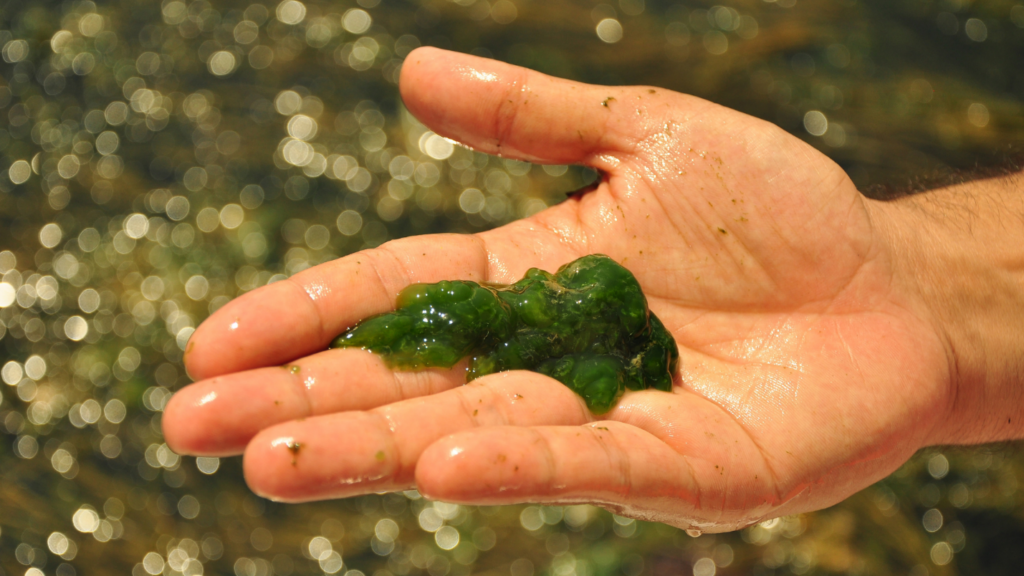
There’s nothing worse than putting time, money, and love into your backyard pond, only to watch it turn into a murky green mess. You were going for crystal clear, Zen-like vibes… not pea soup. So, why is your fish pond green? What causes this color change, and more importantly, how can you fix and prevent it?
At Atlantis Water Gardens, we’ve been building and maintaining ponds across New Jersey for over 20 years. We’ve seen our fair share of green water disasters, and helped hundreds of homeowners reclaim their backyard paradise. If you need help from a top-rated Koi pond company near me in Randolph, then this blog can help you get that water cleared up for good.
Let’s break down the truth about green pond water and how to get your pond back on track.
What Causes Green Water in a Fish Pond?
Green pond water is almost always caused by one thing: algae. Specifically, free-floating single-cell algae, which is different from the kind that grows on rocks or walls.
These microscopic algae multiply fast, especially when conditions are just right (or, just wrong, depending on your perspective). Here’s what fuels the bloom:
Sunlight
Ponds that get full sun are algae’s best friend. Algae use sunlight for photosynthesis, just like your aquatic plants.
Nutrients
Fish waste, uneaten food, and decaying plant matter all break down into nitrates, which algae gobble up.
Poor Filtration
If your pond doesn’t have enough biological or mechanical filtration, excess nutrients won’t be broken down or removed.
Lack of Plants
Without enough aquatic plants to outcompete algae for nutrients, the green guys take over.
Is Green Water Dangerous for Fish?
Not always but it can be.
A little green tint isn’t automatically harmful. But if the algae bloom gets out of control, it can lower oxygen levels in the pond, especially at night when algae consume oxygen instead of producing it.
Low oxygen = stressed or dying fish.
That’s why you may see koi gasping at the surface or hanging near the waterfall, they’re searching for more oxygen. (We’ve covered this behavior in-depth on our blog: Why Are My New Jersey Koi Fish Hanging Around My Waterfall?)
So yes, while algae are a part of every ecosystem, they need to be kept in check.
5 Steps to Fix Green Pond Water
We’re going to walk you through the most effective ways to clear up green water, without harsh chemicals or gimmicks.
1. Improve Filtration
Your filter system is the beating heart of your pond. If it’s undersized, clogged, or not functioning properly, your water quality will suffer.
- Biological filtration (like Aquascape BioFalls) helps grow beneficial bacteria that break down nutrients.
- Mechanical filtration (like skimmers) removes physical debris before it decomposes.
We often upgrade filters for homeowners who find us by searching Koi Pond Company Near Me in Randolph, and the results speak for themselves.
2. Add Beneficial Bacteria
These naturally occurring microbes are your best defense against green water. They break down excess nutrients before algae can use them.
- Apply liquid or dry bacteria regularly, especially after cleaning or water changes.
- Use a high-quality brand designed for ponds, like the ones we install and maintain.
3. Shade Your Pond
Less light = less photosynthesis = less algae.
- Add floating plants like water lilies or water lettuce.
- Build a shade structure or plant strategically to block afternoon sun.
If you’re still planning your pond, we always advise new clients in Randolph to choose a location with partial shade.
4. Limit Fish Food and Waste
Overfeeding is a top culprit.
- Feed only what your fish can eat in 3–5 minutes.
- Remove uneaten food.
- Keep your koi population in check. Too many fish equals too much waste.
5. Ultraviolet Clarifiers (UV Lights)
This is our not-so-secret weapon.
- A UV clarifier kills single-cell algae as water passes through it.
- It doesn’t affect beneficial bacteria or plants, it just clears the green.
We typically install UV units alongside filter upgrades, especially for ponds with chronic algae issues.
How to Prevent Green Pond Water in the First Place
If your water is already clear (or once you’ve fixed the issue), here’s how to keep it that way:
Include Enough Aquatic Plants
🪴 Plants like hornwort, anacharis, and lilies compete with algae for nutrients. More plants = less food for algae.
Maintain Good Circulation
🔄 Dead zones in your pond = stagnant water = algae growth. Use aerators, jets, and waterfalls to keep everything moving.
Clean Your Pond Seasonally
🧼 Even natural ponds need a deep clean. We recommend:
- Spring cleanouts to remove sludge and debris.
- Fall cleanouts before winter shutdown.
- Vacuuming out buildup or hiring a pro (like us) to do the dirty work.
Test Your Water Regularly
📊 Use a pond test kit to monitor:
- Ammonia
- Nitrites/Nitrates
- pH
- KH (carbonates)
Keeping these levels stable helps prevent algae blooms and keeps your fish happy.
What NOT to Do
Some advice out there sounds tempting but can do more harm than good. Avoid the following:
❌ Don’t pour bleach or algaecides into your pond. They can kill beneficial bacteria and your fish.
❌ Don’t cover your pond with a tarp long-term. While it blocks sunlight, it also blocks oxygen exchange.
❌ Don’t ignore the problem. Algae blooms don’t just “go away”, they’ll get worse if left untreated.
Still Struggling with Green Pond Water? Call Us!
Looking for the most trusted Koi pond company near me in Randolph? You’ve found us!
At Atlantis Water Gardens, we specialize in naturalistic koi pond design, seasonal cleanouts, filtration upgrades, and water quality restoration. We’ve been featured as the #1 Aquascape Installer in the world, and we know New Jersey ponds inside and out.
We don’t just build ponds; we build thriving ecosystems. Let’s get your pond crystal-clear again.
Contact us online now or give us a call at 973-627-0515 to schedule a consultation with our expert team today.

Founder & Master Pond Builder
Jaak Harju is the founder and master pond builder of Atlantis Water Gardens, a family-owned design and build firm specializing in natural-looking ponds, waterfalls, and ecosystem water features. Since 2000, Jaak has dedicated his career to creating outdoor environments that inspire connection with nature.
With a background in landscape design and construction, Jaak brings artistry and precision to every project. He’s known nationally for his creative stonework, ecological pond design, and educational outreach within the pond-building community. Through his work, videos, and collaborations with other Aquascape-certified contractors, Jaak has helped redefine backyard water features as sustainable, living ecosystems.